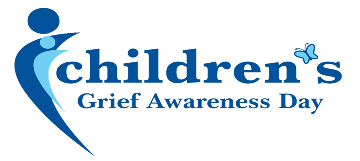Children's Grief Awareness Day
What is Children's Grief Awareness Day?
 Children's Grief Awareness Day is observed every year on the third Thursday in November (the Thursday before the U.S. holiday of Thanksgiving). This time of year is a particularly appropriate time to support grieving children because the holiday season is often an especially difficult time after a death.
Children's Grief Awareness Day is observed every year on the third Thursday in November (the Thursday before the U.S. holiday of Thanksgiving). This time of year is a particularly appropriate time to support grieving children because the holiday season is often an especially difficult time after a death.
Children's Grief Awareness Day seeks to bring attention to the fact that often support can make all the difference in the life of a grieving child. It provides an opportunity for all of us to raise awareness of the painful impact that the death of a significant person has in the life of a child, an opportunity to make sure that these children receive the support they need.
How can I participate?
The most basic way to participate in Children’s Grief Awareness Day is to have as many people as possible—children and adults—wear blue. Publicity about the reason for wearing blue—to show awareness of grieving children—allows the entire community to know what Children's Grief Awareness Day is about.
Visit the National Children's Grief Awareness Day website for more ideas about how to participate with activities for your whole family.
Why raise awareness for grieving children and teens?
Before they graduate from high school, one child out of every 20 children will have a parent die—and that number doesn't include those who experience the death of a brother or sister, a close grandparent, an aunt or uncle, or friend.
Children who have experienced the death of someone important to them often feel like their struggles are invisible to those around them. These children need advocates, letting all know that the death of someone close is the beginning of many weeks, months, and years of finding ways to go on without that special person in their lives, with that person-shaped hole in their hearts.
Children who have experienced the death of a significant person —especially a close family member—can feel the loss forever. They eventually go back to school. They might pick some activities back up. They certainly look "normal." And yet there's still that hole inside.
Grieving children often feel set apart, different from their peers, alone and not understood. Every school and every community has children who have experienced some type of loss. Even if they keep their loss and experience to themselves, there are many children who are grieving among us.
These children can be helped to not feel so alone. Children and adults together can show their support for grieving children and show their awareness of what grieving children might be going through by participating in Children's Grief Awareness Day.
Did You Know?
- 1 in 5 children will experience the death of someone close to them by age 18. (Kenneth Doka, Editor of OMEGA, Journal of Death and Dying)
- In a poll of 1,000 high school juniors and seniors, 90% indicated that they had experienced the death of a loved one. (nahic.ucsf.edu/downloads/Mortality.pdf)
- One in every 1,500 secondary school students dies each year. (nahic.ucsf.edu/downloads/Mortality.pdf)
- One out of every 20 children aged fifteen and younger will suffer the loss of one or both parents. These statistics don’t account for the number of children who lose a “parental figure,” such as a grandparent or other relative that provides care. (Owens, D. “Recognizing the Needs of Bereaved Children in Palliative Care” Journal of Hospice & Palliative Nursing. 2008; 10:1)
- 1.5 million children are living in a single-parent household because of the death of one parent. (Owens, D. “Recognizing the Needs of Bereaved Children in Palliative Care” Journal of Hospice & Palliative Nursing. 2008; 10:1)
- Mortality rates for adults in their 40s and 50s in the past two decades have risen dramatically, making it more likely that younger children will experience the death of a parent, or a classmate’s parent. “Kids are encountering death more often and at a younger age—it’s just inevitable,” says Gerald Koocher, chief of psychology at Boston’s Children’s Hospital. (”Early Grief” Wall Street Journal, Feb. 18,1999)
- It is estimated that 73,000 children die every year in the United States. Of those children, 83 percent have surviving siblings. (Torbic, H. “Children and Grief: But what about the children?” Home Healthcare Nurse. 2011;29(2):67-79)







 Print Article
Print Article